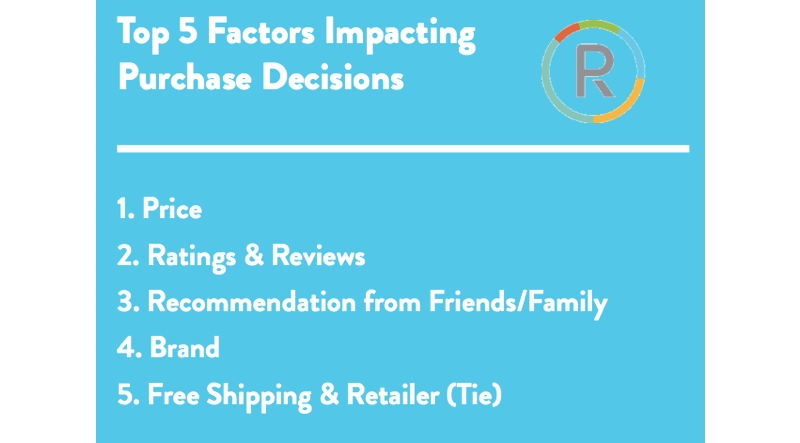
How to Use Customer Reviews to Drive Revenue & Relevance
Would you rate free shipping is an important factor in consumers’ decisions about where to purchase online and even whether or not to make a purchase? Of course you would (thanks, Amazon).
How about a personalized recommendation from a friend or family member? Without a doubt.
Finally, what about customer reviews? Maybe not… but perhaps it’s time to rethink that.
Are You Under-Valuing the Importance of Customer Reviews for Retail Marketing?
For the immense power that customer reviews wield, they get far less attention from retail marketers than they should — and are often under-valued as a result.
Data from PowerReviews reveals that ratings and reviews outweigh recommendations from family and friends, brand, free shipping and retailer in factors that impact purchase decisions.

Why are reviews so important? To start, PowerReviews finds that 95% of shoppers now consult reviews and 66% read between one and 10 reviews before making a purchase. Even more compelling, consumers are 65% more likely to purchase a product with even just one review than they are to purchase a product without any reviews.
Removing the Stigma of Negative Reviews
One of the reasons that retailers tend to steer away from customer reviews is the fear of negative reviews. While you certainly don’t want negative reviews, you shouldn’t let the fear of them hold you back.
In fact, as you begin to rake in reviews, having no negative feedback can actually prove suspicious. After all, wouldn’t it seem a bit strange if you saw a product that had several hundred five-star reviews and nothing else? A negative review here and there not only makes your brand look human, but it also provides valuable customer feedback you can use to improve.
All of that said, Shopify reports that, on average, 75% of reviews are positive. When you couple that with the fact that positive reviews can increase sales by 20%, it’s clear the reward of featuring customer reviews is far higher than the risk.
More Than Sales: How Reviews Help Retail Marketers Stay Relevant
Customer reviews are important because they make shoppers feel comfortable in their purchase decisions and help drive immediate revenue. But that’s just the beginning.
Reviews can also help retail marketers better understand customer sentiment around certain products and power more meaningful, personalized campaigns.
First, understanding customer sentiment makes it possible to better tailor outreach and product recommendations to customers. Second, having a plethora of reviews allows you to run more targeted campaigns, for example by nurturing customers with informative content and by finding new ways to reach customers with “top rated looks.”
Take Pura Vida. The handmade jewelry retailer runs a triggered email that notifies customers who recently viewed but did not buy a product when a new review for that product is available.

3 Tips to Drive More Customer Reviews
Given the importance of customer reviews, how can you encourage shoppers to leave more reviews? Start here:
1) Revisit Your Post Purchase Strategy
When it comes to post purchase, most retailers push an upsell with recommendations to complete the look. It makes sense: Recent purchasers are in buying mode and they’re paying attention to your products.
But does the potential for immediate revenue from a single customer outweigh the potential for a review from that customer that can reach thousands of others and drive revenue time and again in the long term? You might just find that encouraging customers to leave a review is more valuable than pushing another purchase in that moment.
The answer will be different for every retailer, but it’s a question you need to ask. As you answer it, think about ways you can split the difference, too. For example, perhaps you push a second purchase for first-time buyers (because data reveals that the second purchase is the most important factor to making sure one-time buyers don’t become only-time buyers) but you push a review for repeat buyers who have already demonstrated their propensity to return.
Volcom is one retailer that does a great job of bridging the gap between asking for a review and driving another purchase by offering customers who leave a review 20% off their next order and sharing recommended products.

2) Show the Specific Product(s) You Want Customers to Review
Picture this: A customer buys multiple items and receives an email to leave a review. But that email is generic and doesn’t feature any of the products purchased. How does the customer know what products you’re asking her to review?
One of the best ways to increase conversions on product review emails is to show the specific product(s) you want customers to review. Each product should then have a clear call to action that takes customers directly to the review page for that product.
Equally as important, if you ask customers to review multiple products (and you should ask them to review as many products as you can based on their purchase history), each product should have its own image and call to action.
Here’s how Lee puts this advice into action:

3) Create a Centralized Review Page
Following the above scenario in which customers have multiple products they can review, what happens after they click through your email to one product and leave a review? You should make it as easy as possible for them to toggle between products to leave a review for each one — and that means they shouldn’t have to go back to their email to get to the next product’s review page.
Instead, you should have a centralized review page where customers can see all of the products they’ve purchased and can click on each one to leave a review. Additionally, going back and forth from the individual product review page to the main review page should be intuitive.
How Will You Use Reviews to Create More Relevant Experiences?
And there you have it: If you’re not asking customers for reviews and using them to power your marketing efforts, there’s a good chance you’re missing out on revenue and engagement opportunities.
Of course reviews are only one of many ways to create a relevant experience for your customers. To find out what else it takes, check out our eBook on the email personalization problem.





